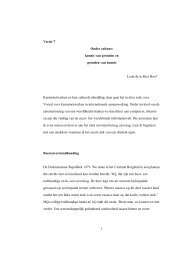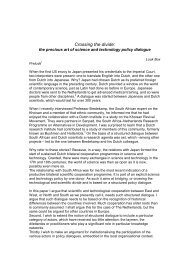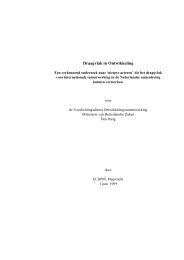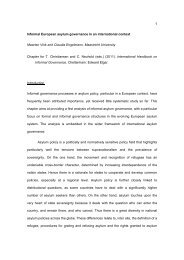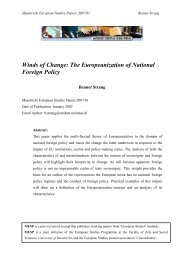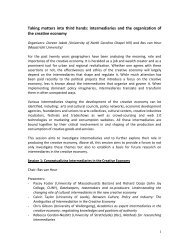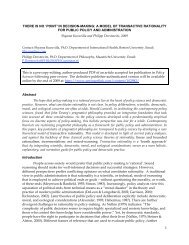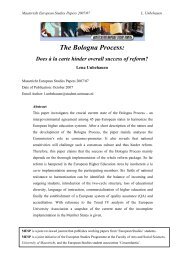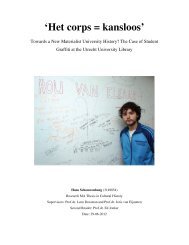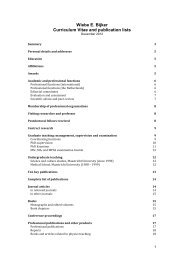the case of the synthetic dye industry, 1857–1914 - Maastricht ...
the case of the synthetic dye industry, 1857–1914 - Maastricht ...
the case of the synthetic dye industry, 1857–1914 - Maastricht ...
Create successful ePaper yourself
Turn your PDF publications into a flip-book with our unique Google optimized e-Paper software.
180 J.P. Murmann and E. Homburg<br />
2 Patterns <strong>of</strong> evolution at <strong>the</strong> global level<br />
Number <strong>of</strong> producers (density)<br />
William Henry Perkin, <strong>the</strong> inventor <strong>of</strong> <strong>the</strong> first syn<strong>the</strong>tic <strong>dye</strong>, started production <strong>of</strong><br />
aniline purple near London at <strong>the</strong> end <strong>of</strong> 1857 and remained <strong>the</strong> only producer<br />
for at least a few months. To commence <strong>dye</strong> production, Perkin also had to<br />
develop processes to make crucial chemical inputs, <strong>the</strong> so-called ’intermediates’<br />
(i.e. organic chemical compounds that are made from raw materials). While some<br />
<strong>of</strong> <strong>the</strong> organic intermediates were already made for o<strong>the</strong>r industrial purposes,<br />
Perkin could not buy all necessary intermediates in <strong>the</strong> market and had to make<br />
nitro-benzene, for example, in-house.<br />
The year 1858 already saw a dramatic increase to 8 firms participating in<br />
<strong>the</strong> <strong>industry</strong>. 4 The number <strong>of</strong> firms continued to increase steeply in <strong>the</strong>se early<br />
years. By 1864 a temporary maximum <strong>of</strong> 68 firms was reached. Over <strong>the</strong> next<br />
fifty years <strong>the</strong> global population grew much more slowly, reaching a peak <strong>of</strong><br />
about 84 firms (see Fig. 1, upper graph).<br />
If we restrict our analysis to <strong>the</strong> five leading countries, Britain, France, Germany,<br />
Switzerland, and <strong>the</strong> USA, <strong>the</strong> patterns look very similar, except for <strong>the</strong><br />
period after 1900, when <strong>the</strong> number <strong>of</strong> firms drops for <strong>the</strong> 5-country aggregate<br />
but rises for <strong>the</strong> entire world. The number <strong>of</strong> firms in a given year is, <strong>of</strong> course,<br />
determined by <strong>the</strong> number <strong>of</strong> firm entries and exits since <strong>the</strong> previous year. Showing<br />
in more detail <strong>the</strong> global <strong>industry</strong> dynamics <strong>of</strong> <strong>the</strong> early years, Figure 2 plots<br />
<strong>the</strong> 3-year moving averages <strong>of</strong> <strong>the</strong> number <strong>of</strong> entries and exits in each year. The<br />
entry graph reveals that <strong>the</strong> largest amount <strong>of</strong> entry occurred very early in <strong>the</strong><br />
<strong>industry</strong> around 1863.<br />
The rapid entry <strong>of</strong> firms between 1858 and 1864 was propelled by a strong<br />
demand for aniline <strong>dye</strong>s, especially in <strong>the</strong> field <strong>of</strong> luxury textiles (silks) and<br />
highly priced fashionable designs. The number <strong>of</strong> syn<strong>the</strong>tic <strong>dye</strong> producers rose<br />
so quickly that <strong>the</strong> intensifying competition soon led to falling prices for <strong>the</strong><br />
new <strong>dye</strong>s. By 1864, <strong>the</strong> price <strong>of</strong> fuchsine (aniline red), for instance, had fallen<br />
to about ten percent <strong>of</strong> <strong>the</strong> 1860 levels (Morris and Travis, 1992, p. 65). A<br />
number <strong>of</strong> firms could not cope with <strong>the</strong> swift decline in prices that resulted<br />
from production overcapacity and were forced to exit. The number <strong>of</strong> exits at<br />
<strong>the</strong> global level peaked in 1864 with 9 exits (see <strong>the</strong> firm exit graph in Fig. 2). 5<br />
The period from 1864 to 1869 was marked by a process <strong>of</strong> consolidation.<br />
Many companies now produced more than a few <strong>dye</strong>s and <strong>of</strong>fered a full “rainbow”<br />
<strong>of</strong> <strong>dye</strong>s to customers. This proliferation <strong>of</strong> syn<strong>the</strong>tic <strong>dye</strong>s led to a decline<br />
in sales <strong>of</strong> such natural <strong>dye</strong>s as archil and cochenille-carmine. 6 But competition<br />
4 All graphs in figures report three-year moving averages.<br />
5 Meyer-Thurow studied contemporary reports <strong>of</strong> chambers <strong>of</strong> commerce in Germany and found<br />
that local <strong>of</strong>ficials became quite aware <strong>of</strong> a crisis in <strong>the</strong> <strong>dye</strong> <strong>industry</strong> in <strong>the</strong> years 1863-4. Manufacturers<br />
complained about falling prices and typically blamed overcapacities for <strong>the</strong> difficulties in<br />
selling product (personal communication to one <strong>of</strong> <strong>the</strong> authors).<br />
6 It took several decades before all natural <strong>dye</strong>s were replaced by syn<strong>the</strong>tic equivalents. Natural<br />
<strong>dye</strong>s such as <strong>dye</strong>woods were produced on a large scale until <strong>the</strong> 1880s and to a lesser extent well



